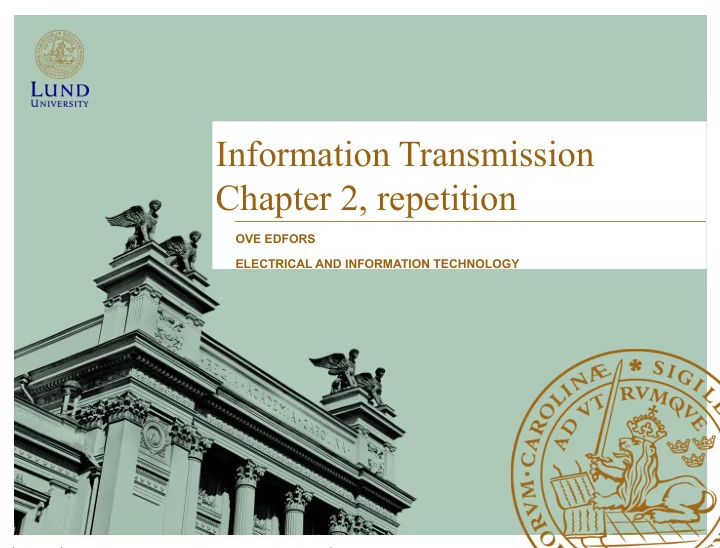

1 Information Transmission Chapter 2, repetition OVE EDFORS ELECTRICAL AND INFORMATION TECHNOLOGY
2 Linear, time-invariant (LTI) systems A system is said to be linear if, whenever an input yields an output and an input yields an output We also have where are arbitrary real or complex constants. 2
3 What does this mean? 3
4 What does this mean • Input zero results in output zero for all linear systems! Superposition: • the output resulting from an input that is a weighted sum of signals is the same as • the weighted sum of the outputs obtained when the input signals are acting separately. 4
5 The delta function When the duration of our pulse approaches 0, the pulse approaches the delta function (also called Dirac's delta function or, the unit impulse ) 5
Properties of the delta function The delta function is defined by the property where g(t) is an arbitrary function, continuous at the origin. 6
7 The output of LTI systems The integral is called convolution and is denoted The output y(t) of a linear, time-invariant system is the convolutional of its input x(t) and impulse response h(t) . 7
8 Example 3 Consider an LTI system with impulse response and input What is the output? 8
9 9
10 Euler’s formula In school we all learned about complex numbers and in particular about Euler's remarkable formula for the complex exponential Where is the real part is the imaginary part 10
11 The transfer function
12 The transfer function is called the frequency function or the transfer function for the LTI system with impulse response h(t) . 12
13 Phase and amplitude functions The frequency function is in general a complex function of the frequency: where is called the amplitude function and is called the phase function . 13
14 An example with a real measured radio channel 14
15 Measurement example, the radio channel • Measurement in the lab • Center frequency 3.2 GHz • Measurement bandwidth 200 MHz, 201 frequency points • 60 measurement positions, spaced 1 cm apart • Measured with a vector network analyzer 15
16 Transfer function - 3 5 - 4 0 - 4 5 - 5 0 - 5 5 ) B d ( - 6 0 p s e r y - 6 5 c n e u q e - 7 0 r F - 7 5 - 8 0 - 8 5 - 9 0 0 0 . 2 0 . 4 0 . 6 0 . 8 1 1 . 2 1 . 4 1 . 6 1 . 8 2 F r e q u e n c y ( H z ) 8 x 1 0 16
17 Transfer function, all positions 17
18 Impulse response - 5 0 What are the - 6 0 delays? How is the signal - 7 0 affected for different delays? ) B - 8 0 d How does it ( p s change with e r e s l time? - 9 0 u p m I - 1 0 0 - 1 1 0 - 1 2 0 0 0 . 5 1 1 . 5 2 2 . 5 3 3 . 5 4 4 . 5 5 D e l a y ( s ) - 7 x 1 0 18
19 Impulse response, all positions 19
20 The Fourier transform
21 The Fourier transform The Fourier transform of the signal x(t) is given by the formula This function is in general complex: where is called the spectrum of x(t) and its phase angle. 21
Spectrum of a cosine Hence we have a Fourier transform pair 22
23 Properties of the Fourier transform 1. Linearity 2. Inverse 3. Translation (time shifting) 4. Modulation (frequency shifting) 23
24 Properties of the Fourier transform 5. Time scaling 6. Differentiation in the time domain 7. Integration in the time domain 8. Duality 24
25 Properties of the Fourier transform 9. Conjugate functions 10. Convolution in the time domain 11. Multiplication in the time domain 12. Parseval's formulas 25
26 Fourier transform of a convolution Since the output y(t) of an LTI system is the convolution of its input x(t) and impulse response h(t) it follows from Property 10 (Convolution in the time domain) that the Fourier transform of its output Y(f) is simply the product of the Fourier transform of its input X(f) and its frequency function H(f), that is, 26
27 Why use Fourier transforms? TIME DOMAIN FREQUENCY DOMAIN Linear system Transformed to analyzed linear system described in described in tme domain frequency domain E.g. convolution Multiplication The detour may be a lot simpler Soluton or Soluton or analysis in analysis in tme domain frequency domain 27
28 Some useful Fourier transform pairs 28
29 Some useful Fourier transform pairs 29
30
Recommend
More recommend